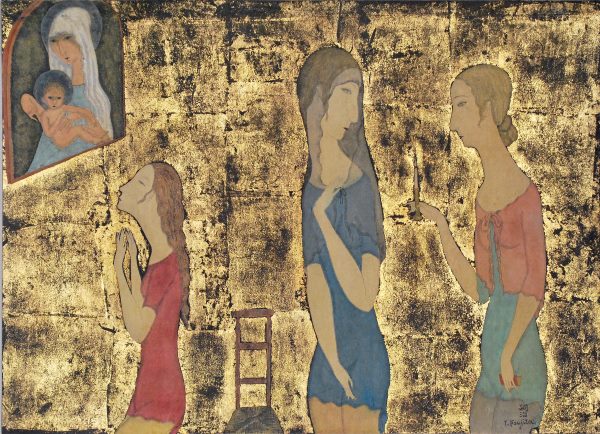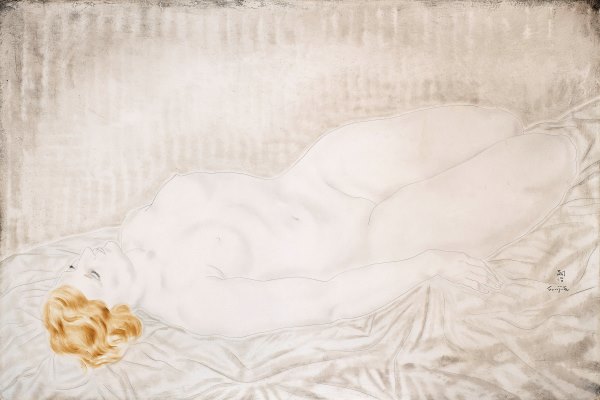In the summer of 1913, an artist arrived in Paris. He was 27 and discovering the city of lights had been his obsession since he was a child in Meiji-era Japan. Foujita Tsuguharu was from a well-off family, the son of a general in Japan’s imperial army and a graduate of the prestigious School of Fine Arts in Tokyo, but he arrived in the French capital as a complete unknown. His goal was to learn, paint and be inspired by the city.


He moved into a studio in Montparnasse and soon met artists like Henri Matisse, Amedeo Modigliani, Chaim Soutine, Fernand Léger, and Pablo Picasso. He worked as a copyist at the Louvre, took dance lessons from Isadora Duncan and staged exhibitions with other painters. In Japanese, Foujita meant “a wisteria field,” but in the Montparnasse circle he soon became known as Fou-Fou, Mad to the power of two. Foujita didn’t mind. He welcomed the notoriety by cultivating a flamboyant image complete with a bowl cut, earrings and a lampshade as a headdress. He added Léonard to his name for a French inflection and as a tribute to Leonardo da Vinci. In the Paris of the Roaring Twenties, he was a star and a natural, more successful than either Picasso or Matisse.

The recent exhibit of Léonard Foujita’s work in the Musée Maillol in Paris examines his work between 1913 and 1931. Even among the many great artists who made up the Paris scene during those roaring years, les Années Folles, he stood out. And not simply for his Greek tunics and crazy antics. Foujita created his own style blending Japanese and western techniques. He worked incessantly on perfecting it, cooking and even sleeping in his Montparnasse studio, with his favorite cat, Miké, for company. Miké was a stray who followed Foujita to his studio and refused to leave.
The first time I saw Foujita’s work was during an exhibition of the artists’ self-portraits. Foujita’s showed him in a studio looking pensive and slightly melancholy, with Miké looking protectively over the painter’s shoulder, one eye at the viewer, another searching his owner. It was such a strange and yet moving image that I wanted to know more about the painter.

It’s not surprising that Miké’s personality was one of the elements that caught my attention in Foujita’s self-portrait. Cats appear time and again in his works. They are always mischievous and mysterious, seeming to know more about the world around them than their owners do. Foujita created a number of paintings and drawings with feline subjects, and his Book of Cats published in 1930 and including 20 etched plate drawings is still among the most sought after by cat lovers.

Another subject that made Foujita famous was a woman with luminous white skin and golden hair. In 1921, Foujita met Lucie Badoul. The young Belgian became his muse, whom he would call Youki, meaning snow. The nude paintings of Youki are among the most poignant and enigmatic in the collection. Whether she reclines gazing into the distance or looks at the viewer directly, there is something disarming, and yet almost disconcerting, about her beauty and radiance. Perhaps because one realizes when returning Youki’s glance that such beauty is as fragile as a snowflake landing on a warm cheek.

Foujita’s delicate brushwork, the use of color and the combination of soft shadows with sharply defined lines give his nudes an ethereal quality. Even more fascinating is the shade of white he used to paint the most captivating of all materials—human skin. Foujita’s white is luminous and pearly and looks like glaze. Foujita kept the composition of his white a secret, but modern technologies allowed us to understand that it was a blend of flaxseed oil, magnesium silicate, and white lead. It recalled the makeup geisha once used to give their skin a pure white glow. Even in photographs it’s mesmerizing, especially when contrasted with Foujita’s trademark tones of grey, yellow and black.

In 1929, the stock market crashed, ushering in the Great Depression. The party and the Roaring Twenties was over. Foujita’s wealthy clients packed their bags and returned to the US. Youki became the lover and later the wife of the surrealist poet Robert Desnos, and Foujita set sail for Latin America with yet another muse.
Foujita spent the next decades looking for a place to call his own. In Japan he served as a propaganda painter to the Japanese Imperial Army during the second world war, and after the defeat he returned to France in 1955. France would be his final destination, a place that accepted and forgave him. He took French citizenship and converted to Catholicism. One of his last projects was a chapel in Reims. Foujita designed it himself and embellished the interior with frescoes, working on the elements of the design until he passed away in 1968. Even as he was slowly succumbing to cancer, he kept painting.
The Foujita Roaring Twenties Exhibit (until July 15, 2018)
The Musée Maillol
Address: 59-61 Rue de Grenelle, 75007 Paris, France
Phone: +33 1 42 22 59 58
http://www.museemaillol.com
Images: photographs taken at The Musée Maillol exhibit, wiki-images.
















34 Comments
Anne: Thank you for such an interesting post! What a personality he must have been. Is there a book about him you can recommend? June 11, 2018 at 9:19am
Victoria: I’ve only read about him in the exhibition catalogue released by the Museum. I’ll have to check if there is something else. June 12, 2018 at 2:35am
Tatiana Owen: Glory in the Line, the Art of Leonard Foujita by Phyllis Birnbaum is an excellent book. I read it recently and found it fascinating and very well researched and written. June 23, 2018 at 1:52am
Victoria: Thank you, Tatiana. June 26, 2018 at 2:46am
Geraldine Ethen: I have never heard of this painter and love his persona and his work! His relationship with cats and “muses” sounds absolutely fascinating! If I was anywhere close to Paris I would run to this exhibit! Thanks for sharing this about Foujita. June 11, 2018 at 10:42am
Victoria: I hope that the exhibit will travel. It’s one of the best I’ve seen this year. June 12, 2018 at 2:34am
Klaas: Great post, Victoria! I don’t know him at all! Well, there you have it, I’ll have to check him out 😉 Warm greetings… June 11, 2018 at 12:07pm
Victoria: I’m happy to have intrigued you to search for more. 🙂 June 12, 2018 at 2:33am
Klaas: Yep, 1920’s Paris, right up my alley! June 12, 2018 at 6:37am
Victoria: I thought so. 🙂 June 13, 2018 at 1:59am
Joy Erickson: Thank you for introducing me to this wonderful artist, Victoria. The subtlety in his nudes is quite amazing. I feel inspired to try these techniques in my own painting. June 11, 2018 at 12:17pm
Victoria: The techniques he used were fascinating. In the 1920s he was far more successful than either Picasso or Matisse. June 12, 2018 at 2:32am
Notturno7: Lovely post, Victoria!
I never heard of this artist and I learned something. Beautiful paintings.
My beloved cat’s name was Miki, he passed away after 17 years in our arms and hearing about Mike was very touching.
Thank you June 11, 2018 at 2:41pm
Victoria: Oh, I’m so sorry to hear about your Miki passing away. June 12, 2018 at 2:31am
Bela: I remember hearing about him a lot when I was a young, in France. He truly was very famous. June 11, 2018 at 5:42pm
Victoria: He fell into oblivion, because his wife put a veto not only on holding exhibits of his works, but also of publishing any reproductions. She passed away about 10 years ago, which is why we can finally rediscover Foujita’s work. June 12, 2018 at 2:29am
Qwendy: I so loved this show, I didn’t realize why one sees so little Foujita around, what a strange choice she made! I was thinking that the paintings are so subtle that they don’t reproduce that well and really need to be seen in the flesh, so to speak. What a truly odd and original artist! More evocations of animals 🙂 June 12, 2018 at 1:18pm
Victoria: During WWII, Foujita worked as a painter for the Japanese Imperial Army. He painted the scenes of battles. After the defeat, everyone associated with the wartime regime was lustrated (or removed from their positions), and Foujita had to leave Japan. His wife was concerned about his reputation, and she was worried that more exposure of his work will bring back the talk of his wartime activities.
An interesting fact is that the American occupation authorities took all of Foujita’s wartime paintings and sent them to the US, where they have remained until recently. There was a show in Tokyo a couple of years ago that finally showed all of these paintings together. June 13, 2018 at 2:11am
Qwendy: I remember the part of his bio film at the Museum when he is part of the war effort, but I missed the rest – sometimes I miss things in French! I guess that is why I have always had a glancing knowledge of his work, probably having seen it in the US a piece at a time! Where did they go and do the Japanese own them now? What a story! June 13, 2018 at 2:50am
Victoria: They’re back to Japan. I don’t remember which museum owns them now, but the exhibit was in Tokyo.
Since Museum Maillol exhibit focused on the 1920s, it didn’t mention much of his life after he left Paris for the South America. In fact, it says almost nothing substantial at all. I ended up reading up on Foujita myself, since for all of the things I discovered, the exhibit left me with many more questions. June 13, 2018 at 7:50am
Amalia: Thank you, for all the new things I have learned from you! June 12, 2018 at 3:29am
Victoria: I’m happy to share! Thank you for reading. June 13, 2018 at 1:56am
Silvermoon: Fascinating! Never heard of him before, so thanks for letting me learn about him. The white used to do the human skin is intriguing. And I wonder where he traveled in South America? Must find out… 😊 June 12, 2018 at 3:06pm
Victoria: He was in Brazil, Argentina, Mexico. June 13, 2018 at 2:13am
Emilie: Thank you for introducing me to these gorgeous paintings! I always find it interesting when an artist has a very distinctive style and the glossy white paint he uses is very beautiful and unique. June 13, 2018 at 2:27am
Victoria: Qwendy is right that the photos don’t do justice to his colors and the luminous finishes, but still, you can see how he used colors and different techniques. June 13, 2018 at 7:52am
zephyr: I’ve seen Foujita’s photograph, the first one in your post, several times. But I never did any research on him; I’m glad you have and have shown us more about him, and this current exhibit. And very interesting about his conversion to Catholism. I’m pearl-obsessed, so I love Youki’s pearly white glow! June 13, 2018 at 1:11pm
Victoria: He was a fascinating character, and I was glad to see the whole exhibit devoted to him. June 18, 2018 at 7:33am
Ingeborg: It is really interesting to learn about different artists you write about. You are very good at picking interesting topics we can all learn from. I should look up this painter since I love both the little I have seen of Japanese drawings and prints and many of the French painters you mention. June 13, 2018 at 4:27pm
Victoria: Glad that you liked it! I was intrigued from the first encounter with his work. June 18, 2018 at 7:34am
Aurora: While I knew of Foujita through the cats, I had never seen the nudes: they are so original, with a quality like whipped cream, I also notice those inky eyes so stricking as the other features are lightly drawn. June 16, 2018 at 9:29am
Victoria: Striking, isn’t it? June 18, 2018 at 7:39am
zephyr: And the hair. Eyes and hair. June 18, 2018 at 6:07pm
Nadine Badra Renom: Hello, I am looking for a poster designed by Foujita to promote a 1929 Ravel concert. It is referred to by Ravel in a letter, hence the importance. Any clue as to where it is or if there is any trace of it?
Kind Regards,
Nadine March 10, 2020 at 7:54am